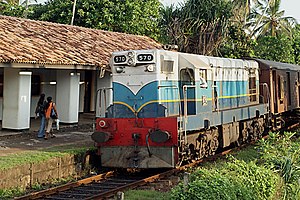Sri Lanka Railways M2

M2 # 570 Alberta which hauled the last "Yal Devi" train to Kankasanthurei. After war began it was trapped there. Later decomposed and shipped to Colombo. Now in use.
|
|||||||||||||||||||||
|
|||||||||||||||||||||
|
|||||||||||||||||||||
|
|||||||||||||||||||||
|
|||||||||||||||||||||
|
Colombo Plan Aid
|
|||||||||||||||||||||
| Type and origin | |
|---|---|
| Power type | Diesel-electric |
| Builder |
General Motors Diesel, Canada (12) Electro-Motive Division, USA (2) |
| Serial number | A608–A609, A720–722, A894–A896, A1325–1326, A1920–A921, 31211–31212 |
| Model | EMD G12 |
| Build date | 1954–1966 |
| Total produced | 14 (now 12 in running condition) |
| Specifications | |
|---|---|
| UIC class | (A1A)(A1A) Bo′Bo′ in M2c sub class |
| Gauge | 5 ft 6 in (1,676 mm) |
| Axle load | 19.75 t (19.44 long tons; 21.77 short tons) |
| Loco weight | 79 t (78 long tons; 87 short tons) |
| Fuel type | Diesel |
| Prime mover | EMD 567C |
| Engine type | V12 Two-stroke diesel |
| Cylinders | 12 |
| Loco brake | Vacuum (Dynamic on M2c and M2d sub classes) |
| Performance figures | |
|---|---|
| Maximum speed | 112 km/h (70 mph) |
| Power output | 1,425 hp (1,063 kW) 1,310 hp (980 kW) in M2d sub class |
| Career | |
|---|---|
| Operators | Ceylon Government Railway » Sri Lanka Railways |
| Class | M2 |
| Number in class | 14 (includes M2-5, M2a-3, M2b-2, M2c-2, M2d-2) |
| Numbers | See table |
| Official name | See table |
| Nicknames | Canadian |
| First run | 1954 |
Colombo Plan Aid
The Sri Lanka Railways Class M2 is a class of diesel-electric locomotive that was developed in the 1954 by General Motors Diesel, Canada, and Electro-Motive Division, USA. This is considered one of the most successful locomotives in Sri Lanka.
It is a General Motors Diesel (Canada) EMD G12 model using the EMD 567C, 1,425-horsepower (1,063 kW) engine.
From 1954, several batches of General Motors-manufactured locomotives were imported to Sri Lanka under "The Colombo Plan". Locally called a "Canadian" engine – there are actually two classes of Canadian engine in SLR – the other one is Class M4. Since these engine were imported under grants from the Canadian government, class M2 locomotives are named with Canadian province and city names. The last two locomotives were made in the United States and imported for Cement Corporation, Sri Lanka. But they were later attached to Sri Lanka Railways locomotive fleet. They were named after two local cities – Galle and Kankasanthurei – where the cement factories were located.
The class entered service in January 1955. "Ruhunu Kumari" Train started using M2 572 " British Columbia" 24 October 1955, the first long distance luxury passenger train service in Sri Lanka. same loco hauled the first "Udarata Manike" Colombo Badulla train on 23 April 1956 and same day started "Yal davi" hauled by M2 569 "ontario", in the far north of the country.
This have been used on both passenger and freight trains on Sri Lanka's railways for over 50 years. Despite the introduction of more modern types of traction, as of 2013 a significant number are still in use.
...
Wikipedia
